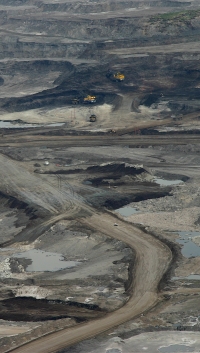Dan Woynillowicz — Mar 04, 2010
First, it was the ducks and now it's the Na'vi: it's shaping up to be a tough week for the oil sands industry.
Already dealing with disturbing videos of ducks struggling in tailings lakes, which have emerged during Syncrude's trial, today the spotlight intensified as environmental and First Nations groups launched an ad in the Oscar edition of Hollywood's Variety magazine. Drawing parallels between the wildly popular movie Avatar (and its native people, the Na'vi) and the oil sands development unfolding in northeastern Alberta, the ad serves to further damage the image of the oil sands. This at a time when the Edmonton Journal was already commenting that the oil sands' image is "back in tar."
With lightning speed, Calgary Herald business columnist Deborah Yedlin and the Canadian Association of Petroleum Producers (CAPP) have tag-teamed to counter the groups' efforts. In Thursday's Herald Yedlin asserted that tying Avatar to the oil sands is a "fairy tale" and rambled through CAPP's talking points about all the benefits from oil sands development and the industry's dedication to protecting the environment. A few hours later CAPP rolled out their PR offensive and a media release to "invite these activists back to planet Earth to discuss the appropriate balance between environmental protection, economic growth and a safe and reliable supply of energy."
This type of response has become par for the course, but what is surprising are Yedlin and CAPP's aggressive efforts to downplay, if not diminish, the concerns of First Nations groups, a number of which supported the Variety ad. It's worth picking these apart as they are a very superficial treatment of the benefits and costs of oil sands development for Aboriginal people.
Let's start with Yedlin's column, "Fairy tale realm no place for oil sands."
This ad in Variety magazine was more bad news for the oil sands industry.
Yedlin feigned surprise that "a number of First Nations are supporting the ad, notwithstanding the fact more than 1,500 First Nations people hold full-time jobs in the oil sands and the fact that more than $3 billion has been netted by First Nations companies between 1998 and 2008."
The pace and scale of oil sands development and a lack of consultation prior to development is why Treaty 6, 7 and 8 First Nations have called for a moratorium on future oil sands development. Perhaps she wouldn't be as surprised had she spoken with any of the First Nations groups to learn why, from their perspective, these apparent benefits don't "balance out" their environmental and cultural concerns.
Next, Yedlin brazenly dismissed ongoing concerns in the community of Fort Chipewyan about the incidence of rare forms of cancer and possible linkages to oilsands development, writing: "As for those who want to talk about cancer rates in northern Alberta, that, too, has been exposed as an example of spurious correlation; the oil sands have nothing to do with what's going on in Fort Chipewyan."
This assertion is just plain uninformed. A health study conducted by Alberta Health Services found residents of Fort Chipewyan experienced a higher incidence rate of cancers than expected, including higher rates of scientific significance for biliary cancers. And the study did not rule out the oil sands as a potential cause, noting that higher incidence rates could be "due to chance, to increased detection, or to increased risk (lifestyle, environmental or occupational) in the community." It went on to recommend continued monitoring and analysis. The jury is still out on this one as new scientific studies detailing oilsands contamination come to light. Environmental groups and First Nations have drawn similarities between the scenes in Avatar and the scenes in Alberta's oil sands.
Moving on to CAPP's release, it noted: "Oilsands development does not go ahead without direct and meaningful Aboriginal consultation about both environmental impacts and economic benefits," while spokesperson Janet Annesly stated: "Aboriginal people are the oil and gas industry's neighbours, employees, contractors and stakeholders. Productive relationships are crucial to oil and gas companies earning their licence to operate."
It went on to provide a bulleted list of the economic benefits (the same cited by Yedlin) to First Nations members and companies. Notably absent was any mention of legal challenges related to oil sands development and First Nations consultation, rights and title, which are currently underway involving the Athabasca Chipewyan First Nation and the Beaver Lake Cree First Nation.
I've been fortunate to have the opportunity to spend time in many First Nations communities, from Fort McMurray, to Fort Chipewyan to remote communities in the Northwest Territories, and have heard the compelling concerns of many First Nations community members first-hand. During the past few years I've witnessed growing and united concern amongst First Nations about the tradeoffs being made between expanding oil sands development and the ensuing impacts on the environment, their communities and culture and traditional ways of life. It seems to me that all is not well with the oil sands industry's "neighbours" when they are asking financiers to stop bankrolling the projects.
As I've noted previously, so long as the oil sands industry and political leaders continue to believe that they have an "image" problem rather than an "impact" problem, the notion of anything remotely resembling responsible oil sands development will be little more than a fairy tale.





heather lehman — Apr 21, 2010 - 08:10 PM MT
The world's dirtiest and most expensive oil comes from Alberta, Canada: tar sands oil. Follow the Na'vi's advice: warn President Obama about dirty tar sands oil at http://action.avatarsands.org
Don't miss the scenes that were too dirty for theaters at http://avatarsands.org
Vivienne — Mar 22, 2010 - 03:53 PM MT
Interesting discussion> I have mentioned your blog in my latest post on the Museum of Anthropology's Blog. Article entitled "Avatar, Oil Sands and First Nations" and have included another side to the discussion, namely that these claims are "fairytales" as posted by the Vancouver Sun. Am interested to hear what you think...
Vivienne — Mar 22, 2010 - 03:51 PM MT
Interesting discussion - I have mentioned your blog in my latest post>
http://www.moa.ubc.ca/blog/2010/03/22/avatar-oil-sands-and-first-nations/
Shereen ALI — Mar 15, 2010 - 10:48 AM MT
Interesting posts.
I am trying to get more informed about the opportunities and costs of tar sands development. As first steps, I am following this website and currently reading Nikiforuk's eye-opening book "Tar Sands."
I am trying to gather some accurate data on exactly how much life is being lost (animals, plants, watersheds, ecosytems), and whether any of this is recoverable.
Can you assist? How much wildlife was there before, and how much is being killed every day? How is the river being affected? I need to quanitify the losses in order to do proper research for a multimedia art exhibition on the tar sands that I am thinking of doing.
Many thanks.
Simon — Mar 16, 2010 - 11:53 AM MT
The impacts on wildlife and biodiversity vary depending on the scale you are looking at. At the scale of an individual oil sands mine site the impacts are severe, and companies and government provide limited information about the quality of habitat that is created after mining should reclamation be successful. Individual environmental assessments for projects will describe the loss of wildlife associated with each project. The permanent loss of some habitat types, such as peatlands, will have implications for those species that rely on these habitat types.
Dan — Mar 16, 2010 - 10:45 AM MT
Hi Shereen,
My colleague Nathan Lemphers would be happy to discuss this with you. You can reach him at nathanl(at)pembina.org.
Cate — Mar 10, 2010 - 03:29 PM MT
Trevor, did you even read this article? Really. The author even directs you to other resources that substantiate his arguments. You are hilarious.
Trevor — Mar 08, 2010 - 09:45 AM MT
I think many of us are getting sick and tired of advocacy groups trying to run our lives with PR firms and life altering non environmental tax schemes and unfounded fear claims.
If people are getting cancer I want proof of the cause not ruling something out as a cause is evidence of nothing. If we have a problem lets tackle, examine it and lets not let movies frame reality. Alberta has some of the toughest environmental standards in the world. If I am wrong proof it.
This article is not dealing in facts just more fantasy we want facsta nd evidence no more fear based speculation.
Trevor
Michael V. Moore — Mar 08, 2010 - 04:14 PM MT
Hi Trevor
We all get whitewased by propaganda at one point or other in our lives but if you have ever traveled, worked, or participated in any way with the tarsands projects you will know first hand that this is the biggest whitewashing scheme in Canada.
The EUB is deeply seated within the pocket of the oil companies who have a vested interest in seeing that these projects go forward unimpeded. The ensuing coverups or greenwashing that results from companies like Suncor trying to offset their eco-footprint across this land with pictures of windmills is insulting to anyone who has seen the truth. The amount of water and gas that is used to obtain the bitumen and then process it for the upgraders located in the US is astronomical and is not sustainable given the rapidly reduced gas fields and the loss of our watersheds. Do your homework and then let's talk.
Oh, one more thing - every politician in this province knows the truth of the health investigations conducted in Fort Chipewyan but it is not a popular subject to be aired in the media.
Phil — Mar 07, 2010 - 10:23 PM MT
So since you don't comment on the Avatar ads, you agree with them since you spend the entire post bashing Yedlin and CAPP?
Don't you guys have any guts to take on other enviromental NGO's who are out to lunch? Or do you congratulate them for spewing as many lies as possible?
Post new comment